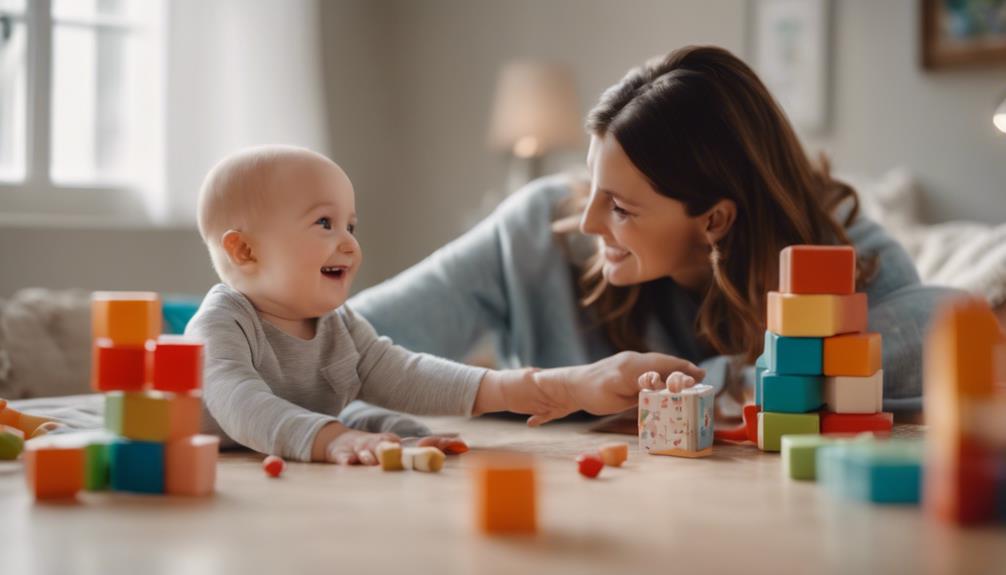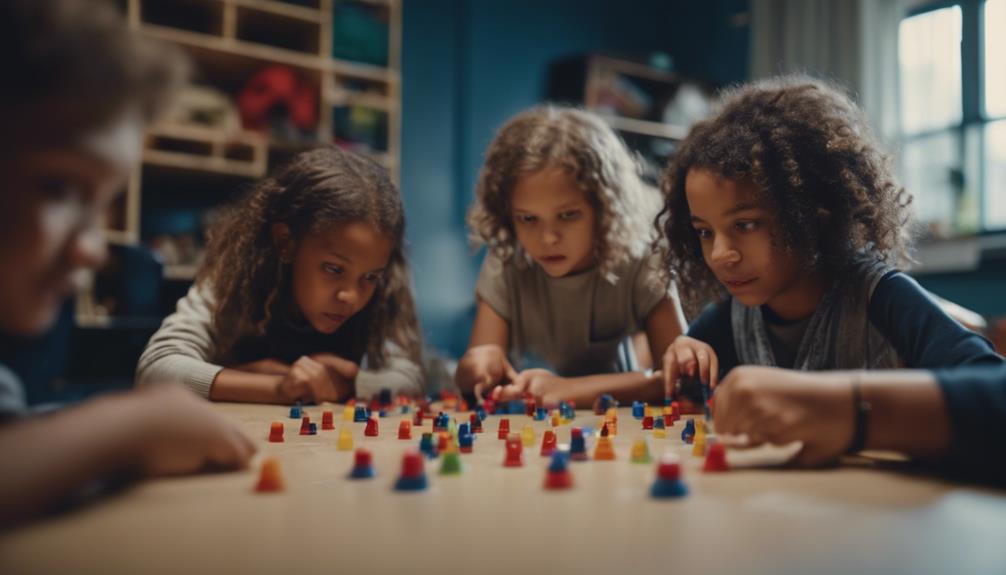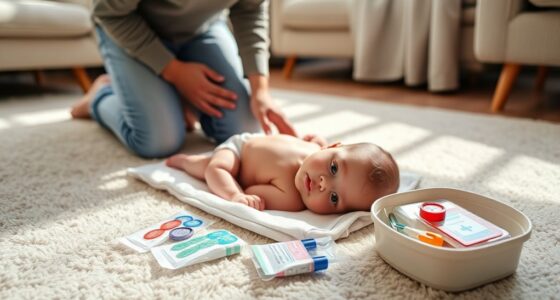To ensure a secure attachment with your baby, it is important to focus on recognizing and responding to their cues and signals. This foundational practice helps strengthen the emotional bond between you and your child. Providing consistent and responsive caregiving helps build trust and security, which in turn supports emotional regulation and exploration. By establishing trusting relationships through predictable routines and affectionate gestures, you can promote emotional well-being. Encouraging parental involvement in nurturing emotional connections and spending quality time together is crucial. Modeling calm and controlled responses helps cultivate a sense of security and trust. Prioritizing positive behaviors and play can also enhance the bond between you and your baby. These key practices create a safe and nurturing environment for your little one.
Key Takeaways
- Respond promptly to baby's cues to strengthen attachment.
- Provide consistent and responsive caregiving for security.
- Foster trust through predictable routines and affectionate gestures.
- Engage actively to nurture emotional connection and joy.
- Model calm responses for emotional regulation and bonding.
Understanding Infant Cues and Signals
To build a secure attachment, you must tune in to your baby's cues and signals. Attachment is vital for children's mental health, shaping their future relationships and emotional well-being.
By understanding and responding promptly to your baby's cues, you create a safe environment where they feel secure and loved. Babies communicate through crying, facial expressions, body movements, and sounds, signaling their needs and emotions. When you pay attention to these cues, you show your child that you understand and care for them, strengthening the parent-child bond.
Recognizing and responding to your baby's signals not only fosters a sense of security and trust but also lays the foundation for healthy attachment patterns in the future.
Consistent and Responsive Caregiving

Understanding your baby's cues and signals is foundational for providing consistent and responsive caregiving. By responding promptly and predictably to your young child's needs, you establish a sense of security and trust crucial for effective parenting. This consistent and sensitive approach helps your baby regulate emotions and explore the world confidently, fostering a secure attachment bond between you as the primary caregiver and your child. Consistency in routines and responses plays a vital role in promoting emotional well-being in young children.
| Benefits of Consistent and Responsive Caregiving |
|---|
| Establishes security and trust in the relationship |
| Aids in emotional regulation and confident exploration |
| Fosters a strong attachment bond between caregiver and child |
Fostering Trusting Relationships

Building trusting relationships with your baby starts with consistent and responsive caregiving. By meeting your baby's needs promptly and warmly, you're laying the foundation for a securely attached and emotionally well baby.
Maintaining predictable routines for feeding, sleeping, and playtime provides a sense of safety and security, allowing your baby to trust in your care. Affectionate gestures like smiling, cuddling, and gentle touch further enhance the bond between you and your baby, fostering a deep sense of connection.
Responding promptly and consistently to your baby's distress signals is vital in promoting emotional well-being and a sense of security in the relationship. Remember, these small but significant actions contribute to the development of a trusting and secure attachment between you and your little one.
Encouraging Parental Involvement
Encouraging your active participation in your baby's daily routines and interactions is vital for developing a secure attachment bond. Parental involvement plays a significant role in nurturing a strong emotional connection with your baby.
By responding consistently to your baby's needs, you're building a foundation of trust and security that's essential for their development. Engaging in activities such as cuddling, playing, and smiling not only fosters joy but also reinforces the attachment relationship between you and your little one.
Prioritizing quality time and attention demonstrates to your baby that they're valued and loved, further solidifying the secure attachment bond. Remember, your presence and engagement in your baby's life are key factors in promoting a healthy attachment that will benefit them throughout their lifetime.
Modeling Calm and Controlled Responses

Demonstrating calm and controlled responses is vital for helping babies regulate their emotions effectively. By modeling calm responses and emotional stability, caregivers provide a blueprint for self-regulation that babies can learn from.
When caregivers react calmly to a baby's distress signals, it promotes a sense of security and trust, laying the foundation for a secure attachment bond.
Babies are keen observers and learn by watching how their caregivers respond to different situations. If caregivers exhibit emotional stability and manage stress and anxiety in a composed manner, babies are more likely to internalize these behaviors.
Consistent modeling of self-regulation not only helps babies regulate their own emotions but also strengthens the caregiver-baby relationship.
In essence, by demonstrating calm and controlled responses, caregivers play a pivotal role in shaping the emotional development of babies and fostering a secure attachment bond based on trust and emotional security.
Promoting Positive Behaviors and Play

Fostering positive behaviors and play is essential for nurturing secure attachment in babies. Research shows that encouraging positive interactions and playtime can strengthen the bond between caregiver and baby, aligning with attachment theory principles. Security Parenting emphasizes the importance of promoting positive behaviors and play to support emotional regulation and social development in infants. When engaging in play activities, make sure to create a safe and nurturing environment that fosters a sense of security and trust in the caregiver. Playful interactions not only contribute to the baby's emotional well-being but also enhance the overall quality of the attachment relationship. By prioritizing positive behaviors and play, caregivers can lay a solid foundation for the baby's emotional development and long-term social skills.
| Benefits of Positive Behaviors and Play | Effects on Secure Attachment |
|---|---|
| Strengthens bond between caregiver and baby | Promotes emotional regulation and social development |
| Fosters a sense of security and trust | Enhances emotional well-being |
Creating a Safe and Nurturing Environment

To guarantee a secure attachment with your baby, focus on creating a safe and nurturing environment that promotes trust and emotional well-being. Consistency in routines, especially during the first few months, like feeding and sleeping, helps establish a sense of security for your little one. Regular displays of affection through smiling, touching, and cuddling have been proven to be related to promoting bonding and attachment.
Responding consistently to your baby's distress signals with warmth and comfort is vital, as this fosters a secure attachment. Encouraging two-way interactions and mutual relationships with your baby enhances the formation of attachment. Creating a nurturing environment with appropriate boundaries and space is important in supporting healthy attachment development.
Frequently Asked Questions
How to Ensure Baby Has Secure Attachment?
To guarantee your baby has a secure attachment, respond promptly to their needs, maintain consistent routines, show affection through smiles and cuddles, encourage interactive play, and build a mutual relationship where both feel understood and valued.
What Are the 4 Key Points on the Importance of Secure Attachment?
You need to know the importance of secure attachment for your baby: emotional regulation, confidence, and success. Research shows securely attached children are happier, kinder, and have better relationships, school performance, and behavior.
What Are 3 Ways You Can Promote Secure Attachments in a Infant or Toddler Room?
To promote secure attachments in an infant or toddler room, focus on consistent caregiving, predictable routines, and responsive interactions. These practices build trust, stability, and emotional connection, laying the foundation for a strong attachment relationship between the child and caregiver.
What Are the 4 Pillars of Secure Attachment?
To promote secure attachment, remember the 4 pillars: availability, sensitivity, responsiveness, and consistency. Be emotionally present, interpret cues accurately, respond promptly, and provide consistent care. These practices nurture trust and build strong bonds with your baby.
Conclusion
To sum up, by understanding your baby's cues, responding consistently, building trusting relationships, staying involved, staying calm, promoting positive behaviors, and creating a safe environment, you can establish a secure attachment with your little one.
So, why wait? Start implementing these key practices today and watch your bond with your baby flourish like never before. Your baby's secure attachment is just a few simple steps away.










